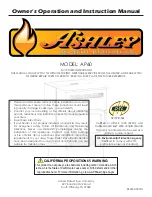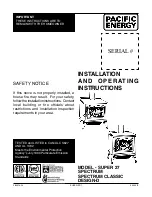
11
Appliance Controls
HOW YOUR STOVE WORKS
Your pellet stove utilizes
a inclined auger fuel feed
system that is operated by
a microprocessor controlled
digital circuit board. The
digital circuit board allows
the inclined auger fuel feed
system to run in a timer-based,
non-continuous
cycle;
this
cycling allows the auger to run
for a predetermined period
of seconds. The auger pushes
pellets up a chute located at
the front/bottom of the hopper
which in turn falls through
another chute into the burnpot.
Your stove is equipped with an
automatic ignition system that should ignite the fuel within 5-10 minutes from pressing the ON button. As pellets
enter the burn pot and ignite, outside air is drawn across the fuel and heated during the combustion process
which is then pulled through the heat exchanger by the exhaust motor or draft fan. As the stove heats up, room
air is circulated around the heat exchanger by means of a room air blower, distributing warm air into the room.
The amount of heat produced by the stove is proportional to the rate of the fuel that is burned, and this rate
is controlled by the “HEAT RANGE” setting. In order to maintain combustion of the fuel at a desired rate, the air
provided to the burn chamber by the exhaust or draft fan must be maintained precisely. Too little air will result in a
flame that is non-energetic or lazy. If the fuel continues to flow with too little air for long enough, the burn pot will
fill with too much fuel and the fire will smother out. To much air will result in a flame that is overactive or aggressive.
The flame in this situation is typically very blue at the bottom and resembles a blow torch. If this situation continues,
the fuel in the burn pot will be consumed and the fire will go out. Matching the amount of air required for proper
combustion to the fuel rate is the primary objective in effectively burning pellets of various brands and qualities
in your stove. The air to fuel ratio can be adjusted to allow almost any fuel quality to burn effectively by following
the procedures detailed in the remainder of this manual. Because a forced draft pressure is required for the
combustion process inside your stove, it is extremely important that the exhaust system be properly installed and
maintained. And, that when operating your stove, you make sure that the viewing door is properly sealed.
PANEL/REMOTE CONTROLS
The blowers and automatic fuel supply are controlled from a panel on the top of the stove.
The control panel functions are a follows.
A.
ON/OFF SWITCH (“POWER” BUTTON)
•
When pushed, the stove will automatically ignite. No other fire starter is necessary. The
igniter will stay on for at least 10 and up to 12 minutes, depending on when Proof of Fire is
reached. The fire should start in approximately 5 minutes.
•
After pushing “POWER”, the auger motor is on for 3.5 minutes, off for 1 minute. During the
remainder of the start-up period, the auger motor operates on the heat range “1” setting.
•
During start up the heat level advance (Up and Down keys) will change the heat range
indicator level accordingly, but there is no change in the stoves operating conditions until
start-up is completed.
•
During start-up ignition must occur within 12 minutes or the stove will error out and show E3.
•
During the start-up phase, the Mode key does not function.
B.
LEVEL / TEMP ARROW BUTTONS
• These buttons when pushed will set the pellet feed rate, hence the heat output or heat
range of your stove.
• The levels of heat output will incrementally change on the bar graph starting from heat
range “1” to heat range “5”.
4 Digit Display
Up / Down
Buttons :
Heat Range
Room Fan
Draft Fan
Auto Mode
Indicator
Auger Delay
Indicator & Button
Off Indicator
& Button
On Indicator
& Button
Digital Control Panel












































